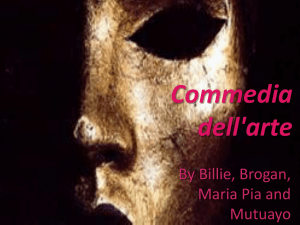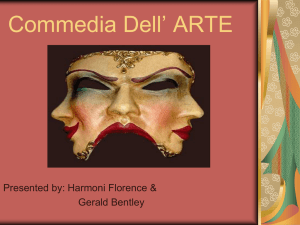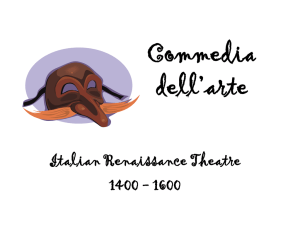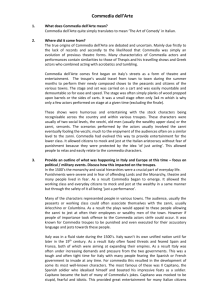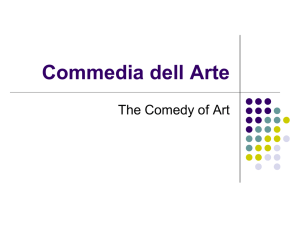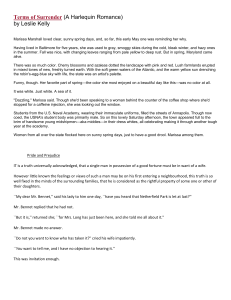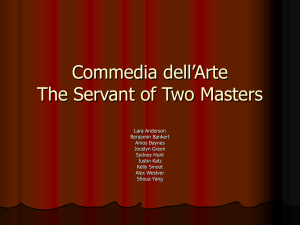Commedia dell'Arte: Characters & History
advertisement
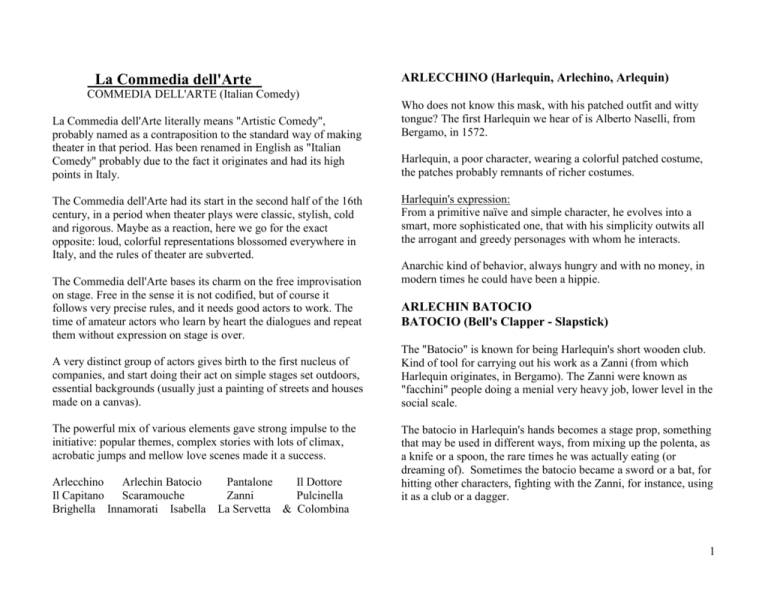
La Commedia dell'Arte ARLECCHINO (Harlequin, Arlechino, Arlequin) COMMEDIA DELL'ARTE (Italian Comedy) La Commedia dell'Arte literally means "Artistic Comedy", probably named as a contraposition to the standard way of making theater in that period. Has been renamed in English as "Italian Comedy" probably due to the fact it originates and had its high points in Italy. The Commedia dell'Arte had its start in the second half of the 16th century, in a period when theater plays were classic, stylish, cold and rigorous. Maybe as a reaction, here we go for the exact opposite: loud, colorful representations blossomed everywhere in Italy, and the rules of theater are subverted. The Commedia dell'Arte bases its charm on the free improvisation on stage. Free in the sense it is not codified, but of course it follows very precise rules, and it needs good actors to work. The time of amateur actors who learn by heart the dialogues and repeat them without expression on stage is over. A very distinct group of actors gives birth to the first nucleus of companies, and start doing their act on simple stages set outdoors, essential backgrounds (usually just a painting of streets and houses made on a canvas). The powerful mix of various elements gave strong impulse to the initiative: popular themes, complex stories with lots of climax, acrobatic jumps and mellow love scenes made it a success. Arlecchino Arlechin Batocio Il Capitano Scaramouche Brighella Innamorati Isabella Pantalone Il Dottore Zanni Pulcinella La Servetta & Colombina Who does not know this mask, with his patched outfit and witty tongue? The first Harlequin we hear of is Alberto Naselli, from Bergamo, in 1572. Harlequin, a poor character, wearing a colorful patched costume, the patches probably remnants of richer costumes. Harlequin's expression: From a primitive naïve and simple character, he evolves into a smart, more sophisticated one, that with his simplicity outwits all the arrogant and greedy personages with whom he interacts. Anarchic kind of behavior, always hungry and with no money, in modern times he could have been a hippie. ARLECHIN BATOCIO BATOCIO (Bell's Clapper - Slapstick) The "Batocio" is known for being Harlequin's short wooden club. Kind of tool for carrying out his work as a Zanni (from which Harlequin originates, in Bergamo). The Zanni were known as "facchini" people doing a menial very heavy job, lower level in the social scale. The batocio in Harlequin's hands becomes a stage prop, something that may be used in different ways, from mixing up the polenta, as a knife or a spoon, the rare times he was actually eating (or dreaming of). Sometimes the batocio became a sword or a bat, for hitting other characters, fighting with the Zanni, for instance, using it as a club or a dagger. 1 The stage batocio was made of two strips of wood, and used as a slap stick, a special effects prop, after all, being able to convey to the public the blows which were given around and give action and exaggeration to the scene it was used in. This is how Harlequin once introduced himself in a play: "Mi son Arlechin Batocio Orbo de na recia e sordo da un ocio" "My name is Arlechin Batocio Blind in one ear and deaf in one eye" PANTALONE (Pantaloon) We see here the mask of Pantaloon (Pantalone in the original Italian name), the Venetian merchant, rich, greedy and naïve. From merchant to nobleman, always having to deal with people trying to take his gold from him, always losing against wit and improvisation, at times even pleasant for the trust he feels for the others, that on the other hand don't care for anything different than his money. … e Pantalone paga!!! (…and Pantaloon has to pay!!) image of the Italian people been subject to the state's squeezing tax system … Old but athletic, Pantaloon plays the ideal counterpart of an Harlequin always without money, the Zanni, poor immigrant always hungry, Brighella (the name comes from briga, fight), and countless other characters. IL DOTTORE (The Doctor) DOTTOR BALANZONE (Dottor Baloardo) The name coming from "balle"(lies) gives well the idea of this mask, which knows everything supported by his science, arrogance and ignorance. Born in Bologna, at the time in which the University was well established in the capital of Emilia (second half of 16th century). Balanzone is rather fat (fat = rich), always dresses in black, is well groomed, rich looking, and talks and talks, a river of ostentatious useless science, teasing the current exaggerated belief in science and humanism. The Doctor is the second old folk together with Pantaloon in the Commedia dell'Arte, and first appears on stage in the mid 16th century, with the name of Graziano (or Grazian Baloardo), which later became Dottor Balanzone. The Doctor character is normally used in the Commedia dell'Arte plays to put a break in the action, with empty, pre-fabricated and supposedly erudite monologues. Sort of a drums or bass solo in Jazz, which gives the time to the other musicians to take a break and go drink something or put a new reed on their saxophone. The Doctor is member of every academy (known or unknown) he knows everything and makes citations in cultivated Greek or Latin; too bad they are never right. On stage he is very seldom a medicine doctor for real, he more often impersonates a Lawyer, a Judge, or the Notary Public. Popular belief, hostility toward these "I know everything" characters, shows how the "Commedia dell'Arte" used to characterize and make irony on everyday life, pulling the leg on every established belief, anarchic force in a rigid and schematic world, with the typical Italian humor and self-irony. 2 IL CAPITANO (The Captain) The mask of the Captain with all certainty widely pleased the population which was oppressed by those mercenary occupation armies, as very often happened in the Italy of 16th century (even before and after, as a matter of fact ...), kind of a platonic revenge toward the oppressor, and especially toward the mercenary soldiers, mainly ignorant, violent brutes who would take advantage in all senses of the poor subordinate populations. First Captains ever in the Commedia dell'Arte were Italians in the speech and uniforms, these being as much as possible an exaggeration of the real ones, and changed with time, armies and fashion. The Captain mask later became of Spanish origins (Borboni!) and with his heavy Spanish accent and pitiless irony built around his figure sometimes created some animosity in the audience. The Captain soon disappeared from the Commedia's usual cast, his last appearances date from the beginning of the 18th century. Several names apply to the Captain in his hundred and some years of Commedia activity: Capitan Spavento di Vall'Inferna (Captain Fright of Hell's Valley) was definitely the most widely known, but also others, Capitan Fracasso (Big Noise, but also Failure in Spanish), Terremoto (Earthquake), Spaccamonti (Mountain Burster), Sangr y Fuego (Blood & Fire -Sp.), Matamoros (Moors Killer -Sp.), Spezzaferro (Iron Breaker), Rodomonte (probably deriving from the Rhodes Colossus, meaning a huge and very powerful man). Also Scaramouche starts up as a Captain, but later on he gets a life of his own. Long pointy moustaches, huge sword (never used), several daggers at his belt, the Captain talks more than he actually fights, he's very brave in his own words, but usually gets scared and flies off stage when Harlequin enters with his "batocio", Harlequin's short wooden club. SCARAMOUCHE (Scaramuccia) By year 1680 the Spanish Captain goes out of vogue, so another kind of Captain, Scaramuccia (better known as Scaramouche as he was widely popular in France and England) took over the image. Scaramuccia literally means "small, fast fray" giving the idea of a soldier who doesn't involve himself too much in the battle, and this is his way of fighting too, a little touch here, a short attack there. More of a woman hunter than a soldier, in reality, great friend of Pulcinella, Scaramouche is less boasting than his predecessors, and more adroit and clever, besides being lucky in his maneuvering, he always finds a way of reversing the consequences of his acts on somebody else. The mask of Scaramouche is indelebly tied to Tiberio Fiorilli, who impersonated it all his life, and made the character famous and appreciated all around Europe. Wherever he went Scaramouche was received with great enthusiasm, his success terrific. Talented and artistic, the Fiorilli-Scaramouche was also strong, agile, graceful, sang with a good voice and played the lute. This is also why in most of the prints of Scaramouche show him with a lute or a guitar Fiorilli's fame spread fast into France and England, where he was always invited to play for the Kings and Queens of the time. 3 One of the more recognized talents of Fiorilli was his great ability with the pantomime, and the ability he had to transmit emotions, not only laughter, to the audience only through gesturing. The Zanni defines more a kind of mask, but not a particular one, although on several occasions he gets the name of Zany Cornetto. He's friend / antagonist of Harlequin, of which he shares not only the roots, but the basic needs, food and lack of nobility. The ZANNI PULCINELLA (Polichinelle) Zanni, as much as Harlequin, is originary from Bergamo. The lower Bergamo of course, "Bergam de hüta", where all the poor come from, and he's part of that emigrant population that has to mingle into an hostile environment to survive. Zanni means the first name "Giovanni" in the dialect of Bergamo, the most common of all Italian names, sort of a John Doe of the times. The Zanni can be recognized, with good approximation, as the matrix on which other masks were created. Harlequin, for instance, had (especially in his first years) so much of the Zanni character, that was almost a reflection of it. In later times we also have a primo and secondo Zanni that in a certain way replicate that situation (the smart Harlequin, the dumb Zanni). Pulcinella, also, in the way he dresses, the typical "poor folk" uniform, is basically a Zanni, although developing a very personal pattern very soon. Brighella too, shares the hunger and the way he leads his life, no real clue of what goes on, his life an improvisation after another just trying to get by. Typical feature of the Zanni: poor, desperate, ignorant but smart in his own way, everybody makes fun of him. In a second period he gets his revenge, though, and outsmarts many. He's constantly hungry, and constantly exploited, the primo Zanni smart while the second Zanni hopelessly stupid. Pulcinella is another example of witty but somewhat different character that emerges powerfully from the Commedia dell'Arte. Philosophical, eternally melancholic, dreamer as only a representative of the Neapolitan culture could be, Pulcinella has a spirit all of his own. No tensions or despair, his melancholic approach to life makes him coast problems, situations, live adventures and at the end simply getting out of everything, in the same simple manner as how he got involved. A positive approach to life, his winning strategy. Various masks or costumes were part of the character, as its evolution went on, but what got in the imaginary was the white, simple, poor costume with the sugar loaf hat (the "coppolone"), his dreamy way of being, his poetry and simple philosophy. BRIGHELLA As much as Harlequin and the Zanni, Brighella is from Bergamo too (somebody had some resentment toward the Bergamascos? Who knows), with some resemblance in the basic character to the Zanni. But if not smarter, Brighella's arrogance surely pays off as he gets a little more respect than the Zanni himself. 4 The name by itself (briga, brigare is Italian for quarrel, trouble, intrigue) explains this mask well enough: Brighella is colleric, violent, exaggerated in his behavior, womanizer. Catlike and sordid in his quest for food, confirmed liar and persuasive in his love pursuits, always ready for intrigue, always in search for the next fight. Brighella is a mask used to play different roles, kind of the perfect substitute villain, thus leading to a good deal of variants: Buffet, Flautino, Bagatino, Gandolino, Mezzettino, Fenocchio, Scapino and Beltrame da Milano the most known. GLI INNAMORATI (The Lovers) The Lovers bring into the Commedia dell'Arte those little touches of soap opera and feuilleton around which the action may easily be developed. Important in their role as much as with a flat personality (they're desperately in love ...) the Innamorati helped the public to identify and sink deep in the stories. Elegantly dressed as the last vogue required (usually of the same color, just in case another couple of Lovers was in the play too, in which case we talk about First Lovers and Second Lovers) they reaffirm how much they were made for each other, the Innamorati create those situations of contrasted love, envy, gossip in which to implement the more famous/entertaining masks: Harlequin, Pantaloon, Pulcinella. Very often they are son and daughter of the two old folks, Pantaloon the greedy and the Doctor. The Lovers are young, wear no mask, and have a very strict but essential role in the play, and are a constant of the Commedia dell'Arte, and the action which gets the appreciation of the public any time Harlequin gets on stage. Isabella, Colombina (more versatile, playing the Soubrette too) Silvia, Corallina, the more known Female Lovers, and Lelio, Flavio, Orazio, Silvio, Leandro and others are the men, all with a simple name, easy to remember (in contrast with the Captains, sometimes with very elaborate and noble-like names). The Lovers never really made it into becoming a strength of the Commedia, but since the earlier times have always been present and necessary for the development of the action and of the canovaccio on which the stories were built. Not so different as today's blockbusters from Hollywood, after all. ISABELLA The Isabella character is certainly the most known among all female Lovers, due to the great intelligence and stage performance of Isabella Andreini, (who received and made hers forever) the Isabella role starting probably in 1578. At the time in which the Commedia dell'Arte was a big hit, as much as in the ancient Greek Theater tradition, women did not perform on stage. So the novelty of having real women acting added to the appeal. And Isabella Andreini was a great, famous and cherished actress, cultivated and a poet of considerable talent, and also quite daring on stage. Gossip says that several times she took out or ripped her clothes on stage. Always motivated by the script, though. 5 Anyway, as the old say goes: "Tira più un pelo di figa che un carro di buoi". You won't have me translate this one, though. Sorry. COLOMBINA LA SERVETTA (The Soubrette) Colombina debuts with this name only by the end of 17th century as the Soubrette of the Commedia dell'Arte who gets more personality of her own. The Soubrette is one of those characters which appeared in the Commedia dell'Arte in almost all plays, although keeping a low profile which got more personality with time, developing into more elaborate and important characters such as Colombina, Corallina, Franceschina, Mirandolina and, in one of her disguises, also Arlecchinetta. But the original Soubrette which in Italy continued to fit in the cast remained almost unchanged, usually simple at heart, witty, vane, chatterer, a little clumsy, always present as a "spalla" (counterpoint) to more defined and cherished masks, such as Harlequin, Pantaloon. Her dress always remained simple, wearing no mask, as most of the female characters. One of the Soubrette, Franceschina marries Harlequin with the consent of Pantaloon, but sometimes she's Pantaloon lover, too. Doubtful moral as a rule, the simplicity of the Soubrette coincides with her availability, easiness and love of life and of intrigue to play behind somebody's back. Colombina is what the Innamorata is not: free, insolent, not slave of love bonds, sometimes brilliant, vane always, chatterer, gossiper, always prone to intrigue at somebody else's expenses. A sort of Harlequin in female clothes, and in fact she comes up in certain setups as Harlequina (Arlecchinetta), with a patched costume duplicate of Harlequin's. She is usually Harlequin's companion, and only woman to sometimes wear a mask on stage, Colombina brings that female pepper and intransigence to the plot. Colombina is very often one of the reasons of fights among Pantaloon (her employer, almost owner, sexual harassment was not a concern at the time, more like a habit) and Harlequin (her lover). We can easily imagine which kind of situations (and puns) may originate from such a setup. Carlo Goldoni uses the Colombina character quite a bit in his plays, the wisdom of the simple, the truth revealed even if hard to accept. A woman with the freedom of betraying, of playing games of free morals, but still a servant, nonetheless ... 6

